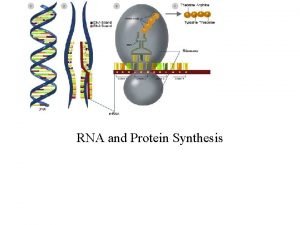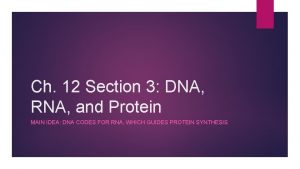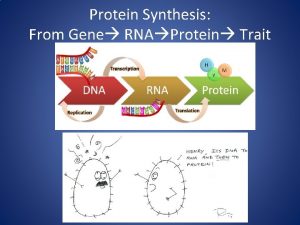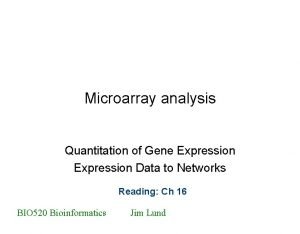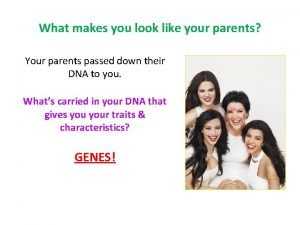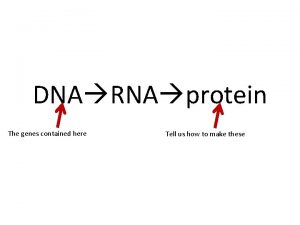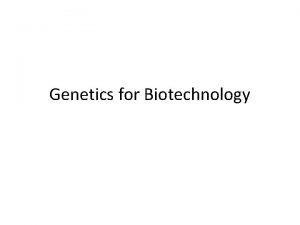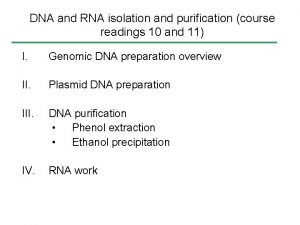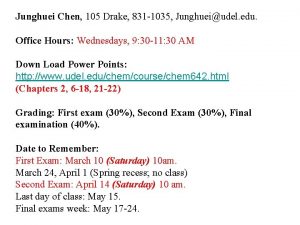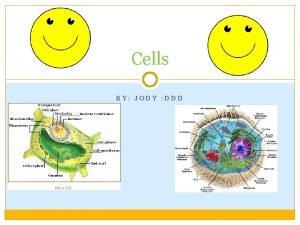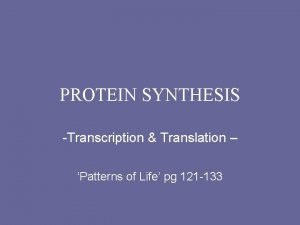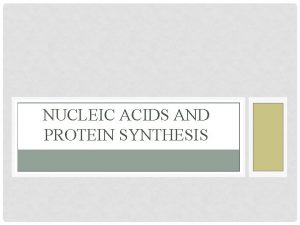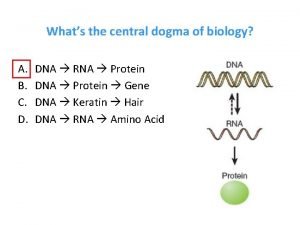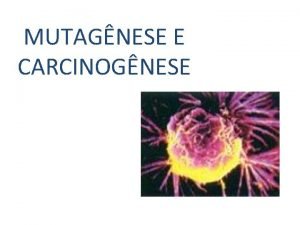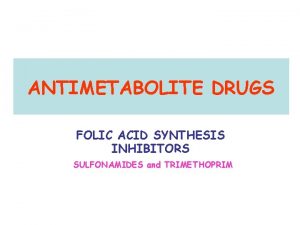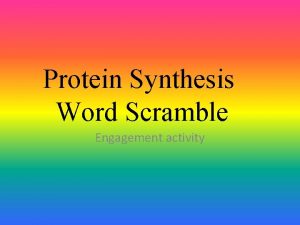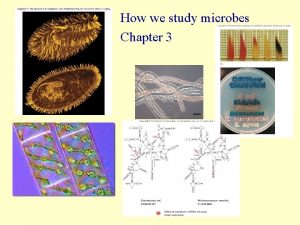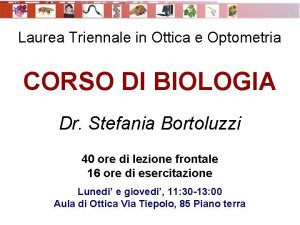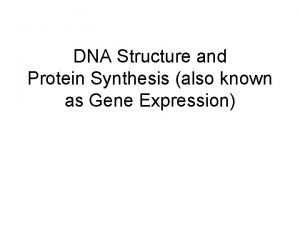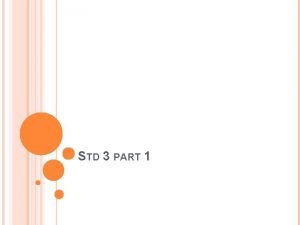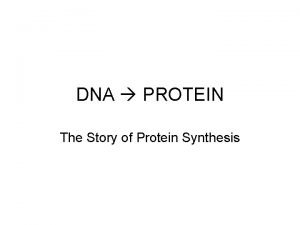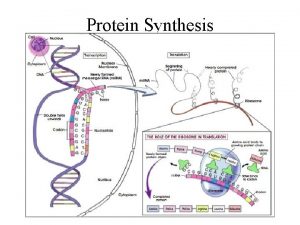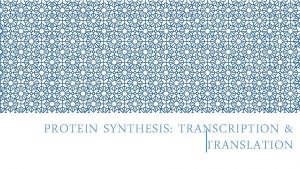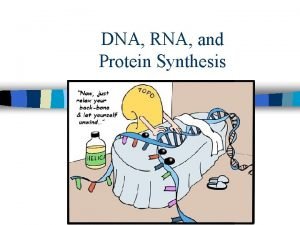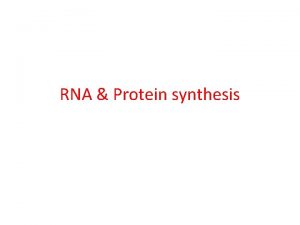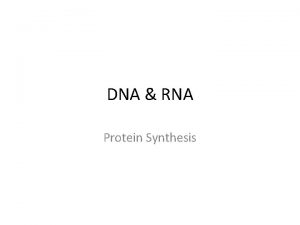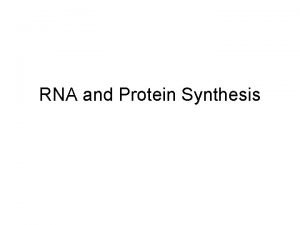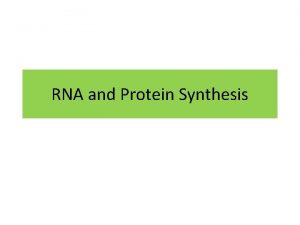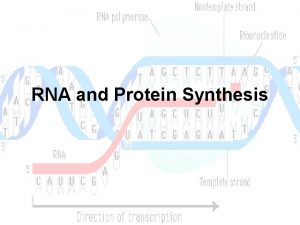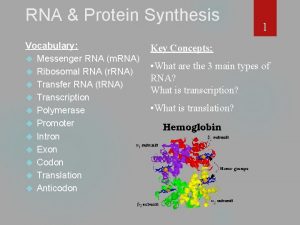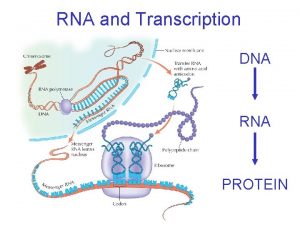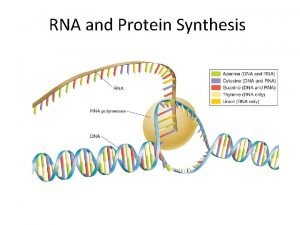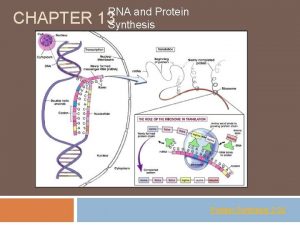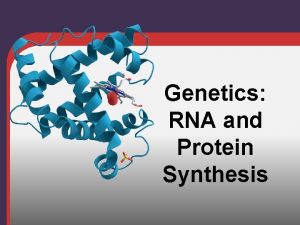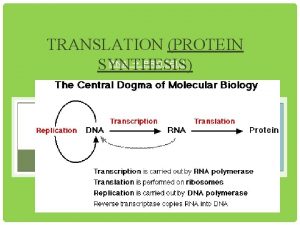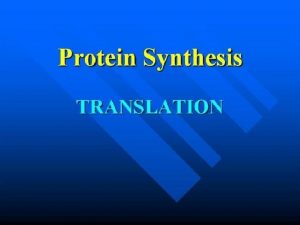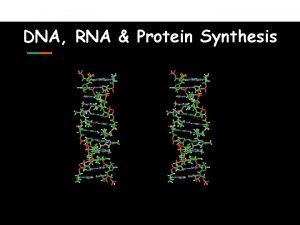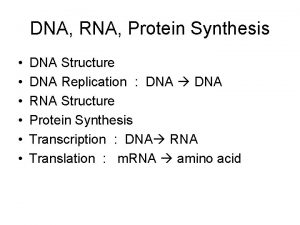DNA RNA Protein Synthesis DNA DNA is made






























- Slides: 30

DNA, RNA, & Protein Synthesis

DNA • DNA is made up of nucleotides. • Each nucleotide is made up of 3 basic parts: – A deoxyribose sugar – A phosphate group – A nitrogenous base: Adenine, Guanine, Thymine, Cytosine

Chromosome Nucleosome DNA double Coils Supercoils Histones helix

Section 12 -1 Figure 12– 7 Structure of DNA Nucleotide Hydrogen bonds Sugar-phosphate backbone Key Adenine (A) Thymine (T) Cytosine (C) Guanine (G)

Section 12 -2 A Perfect Copy Before a cell can divide, the DNA must be copied so that there are two sets ready to be distributed to the new cells.

DNA Replication • During S phase of the cell cycle the DNA copies itself. • During replication, the DNA molecule separates into 2 strands, then produces 2 new complementary strands following the rules of base pairing. • Each strand of the double helix serves as a template or model for a new strand.

How Does Replication Occur? • Enzymes unzip the DNA molecule – Hydrogen bonds between nitrogenous bases are broken & strands unwind • Each strand becomes a model • DNA polymerase helps to connect new base pairs, forming the new strands

Prokaryotic Chromosome Structure Section 12 -2 Chromosome E. coli bacterium Go to Section: Bases on the chromosome

Section 12 -2 Figure 12– 11 DNA Replication New strand Original strand DNA polymerase Growth Replication fork. Nitrogenous bases Replication fork New strand Original strand

RNA • RNA, like DNA, is a nucleic acid. • chain of nucleotides • Each nucleotide has three parts – A 5 carbon sugar (ribose) – A phosphate group – A nitrogenous base • Adenine, Guanine, Cytosine, Uracil

Base Pairing in RNA • Cytosine – Guanine • Adenine - Uracil

Types of RNA • There are 3 main types of RNA. – Messenger RNA – Ribosomal RNA – Transfer RNA

Types of RNA • Most genes contain instructions for making proteins. • Messenger RNA – Molecule that carries copies of instructions to make proteins

Types of RNA • Proteins are made by ribosomes. • Ribosomal RNA – Ribosomes are made up of several proteins and ribosomal RNA.

Types of RNA • During the building of a protein, a third type of RNA transfers amino acids to the ribosome. • Transfer RNA – Molecule that transfers information from m. RNA to the ribosomes.

Differences Between DNA & RNA • DNA – Double stranded – Contains deoxyribose – Adenine-Thymine Guanine-Cytosine – Contains genetic information to code for an individual • RNA – Single stranded – Contains ribose – Adenine-Uracil Guanine-Cytosine – Involved in protein synthesis

Transcription • The process by which RNA molecules are produced by copying a part of DNA into a complementary sequence of RNA. • Requires RNA polymerase – Binds to DNA – Separates strands of DNA – Uses 1 strand as a template to make RNA • Takes place in the nucleus

Section 12 -3 Figure 12– 14 Transcription Adenine (DNA and RNA) Cystosine (DNA and RNA) Guanine(DNA and RNA) Thymine (DNA only) Uracil (RNA only) RNA polymerase RNA DNA

PIANO EXAMPLE • Every cell in your body has the same "blueprint" or the same DNA. Like the blueprints of a house tell the builders how to construct a house, the DNA "blueprint" tells the cell how to build the organism. Yet, how can a heart be so different from a brain if all the cells contain the same instructions? Although much work remains in genetics, it has become apparent that a cell has the ability to turn off most genes and only work with the genes necessary to do a job. We also know that a lot of DNA apparently is nonsense and codes for nothing.

The Genetic Code • Proteins are made by joining amino acids into long chains called polypeptides. • There are 20 types of amino acids. • The language of m. RNA instructions is called the Genetic Code.

The Genetic Code • In the m. RNA “language” there are 4 letters: A, U, C, G • The genetic code is read 3 letters at a time • Each set of 3 bases in m. RNA is called a codon.

Section 12 -3 Figure 12– 17 The Genetic Code

Translation • The information in m. RNA serves as instructions on how amino acids should be put together to form proteins. • Decoding a m. RNA message into a polypeptide chain is called translation. • Proteins are produced. • Occurs in the cytoplasm.

translation • During Translation (continued) – The ribosome continues to bind the amino acids – Chain grows until a “stop” codon is reached, completing the process of translation

Section 12 -3 Figure 12– 18 Translation Nucleus Messenger RNA is transcribed in the nucleus. Phenylalanine t. RNA The m. RNA then enters the cytoplasm and attaches to a ribosome. Translation begins at AUG, the start codon. Each transfer RNA has an anticodon whose bases are complementary to a codon on the m. RNA strand. The ribosome positions the start codon to attract its anticodon, which is part of the t. RNA that binds methionine. The ribosome also binds the next codon and its anticodon. Ribosome Go to : m. RNA Transfer RNA Methionine m. RNA Lysine Start codon

Figure 12– 18 Translation (continued) Section 12 -3 The Polypeptide “Assembly Line” The ribosome joins the two amino acids— methionine and phenylalanine—and breaks the bond between methionine and its t. RNA. The t. RNA floats away, allowing the ribosome to bind to another t. RNA. The ribosome moves along the m. RNA, binding new t. RNA molecules and amino acids. Lysine Growing polypeptide chain Ribosome t. RNA m. RNA Completing the Polypeptide m. RNA Ribosome Translation direction The process continues until the ribosome reaches one of the three stop codons. The result is a growing polypeptide chain.

Gene Mutations • Gene mutations involve a change in a single gene. • Ex: point mutations – Occur at a single point in the DNA sequence; affect a single nucleotide • Substitutions • Ex: frame shift mutations – Changes that affect the reading frame of the genetic message • Insertions, deletions

Gene Mutations: Substitution, Insertion, and Deletion Section 12 -4 Substitution Go to : Insertion Deletion

Chromosomal Mutations • Mutations that involve an entire chromosome. • Deletions= loss of all or part of a chromosome • Duplications= a segment of the chromosome is repeated • Inversion= part of the chromosome is oriented in a different direction than usual (all parts of the chromosome are still present) • Translocation= part of one chromosome breaks off and attaches to another, nonhomologous, chromosome

Deletion Duplication Inversion Translocation
 Dna and genes chapter 11
Dna and genes chapter 11 Dna rna and protein synthesis study guide
Dna rna and protein synthesis study guide Rna transfer
Rna transfer Rna protein synthesis
Rna protein synthesis Section 12 3 rna and protein synthesis answers
Section 12 3 rna and protein synthesis answers Messenger rna codons
Messenger rna codons Chapter 12 section 3 dna rna and protein
Chapter 12 section 3 dna rna and protein Protein
Protein Dna rna protein
Dna rna protein Que es
Que es Dna rna protein
Dna rna protein Dna rna protein central dogma
Dna rna protein central dogma Dna rna protein diagram
Dna rna protein diagram Synthesis of rna
Synthesis of rna Small grain like body made primarily of rna
Small grain like body made primarily of rna Protein synthesis animation mcgraw hill
Protein synthesis animation mcgraw hill Protein synthesis
Protein synthesis Guac wheel biology
Guac wheel biology Protein synthesis
Protein synthesis Paba
Paba Protein synthesis and mutations
Protein synthesis and mutations Bbc bitesize protein synthesis
Bbc bitesize protein synthesis Protein synthesis scramble
Protein synthesis scramble Molecular genetics
Molecular genetics Ribosome
Ribosome Rna types
Rna types Sintese de proteinas na celula
Sintese de proteinas na celula Double stranded dna
Double stranded dna Which best summarizes the process of protein synthesis?
Which best summarizes the process of protein synthesis? Protein synthesis story
Protein synthesis story 4 steps of protein synthesis
4 steps of protein synthesis


